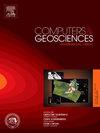基于深度学习的电磁充水体位置预测参数反演
IF 4.4
2区 地球科学
Q1 COMPUTER SCIENCE, INTERDISCIPLINARY APPLICATIONS
引用次数: 0
摘要
瞬变电磁法(TEM)广泛用于隧道施工前的低电阻率区识别。然而,由于地下隧道的空间有限以及TEM反演的非唯一性,在整个地下进行二维或三维地电模型反演是不切实际的。我们设计了一种隧道电磁节理扫描观测系统,并提出了一种基于深度学习的参数反演方法,用于改进的隧道电磁成像,专门用于充水构造的隧道预测。它采用一种配置,其中发射器沿着表面扫描,而接收器位于隧道内,采用时域和频域发射器以及多组件接收器。DL模型首次提供了两种不同视图的参数化成像,形成了一种自检机制,有助于约束预测,减少反演的非唯一性。经过合成数据的训练,我们的系统在预测充水异常的三维空间位置方面表现出令人印象深刻的适应性,并且在不同的隧道环境(包括金属推理和起伏地形条件)下具有很强的鲁棒性。本文章由计算机程序翻译,如有差异,请以英文原文为准。
A deep learning-based parametric inversion for forecasting water-filled bodies position using electromagnetic method
The transient electromagnetic method (TEM) is extensively employed for identifying regions with low resistivity ahead of tunnel construction. Nevertheless, performing a 2D or 3D inversion of geo-electric models across the entire subsurface is impractical due to the limited space within the underground tunnel and the non-uniqueness associated with TEM inversion. We design a tunnel electromagnetic joint scan observation system and present a deep learning-based parametric inversion for improved tunnel electromagnetic imaging, designed specifically for tunnel prediction of water-filled structures. It utilizes a configuration wherein transmitters scan along the surface while receivers are positioned within the tunnel, employing time-domain and frequency-domain transmitters and a multi-component receiver. The DL model for the first time provides parametric imaging of two different view, forming a self-checking mechanism, which can help constrain the predictions and reduce the non-uniqueness of the inversion. Trained by synthetic data, our system shows impressive adaptability to predict the 3D spatial position of water-filled anomalies and strong robustness under different tunnel environments including metal inference and undulating terrain conditions.
求助全文
通过发布文献求助,成功后即可免费获取论文全文。
去求助
来源期刊

Computers & Geosciences
地学-地球科学综合
CiteScore
9.30
自引率
6.80%
发文量
164
审稿时长
3.4 months
期刊介绍:
Computers & Geosciences publishes high impact, original research at the interface between Computer Sciences and Geosciences. Publications should apply modern computer science paradigms, whether computational or informatics-based, to address problems in the geosciences.
 求助内容:
求助内容: 应助结果提醒方式:
应助结果提醒方式:


